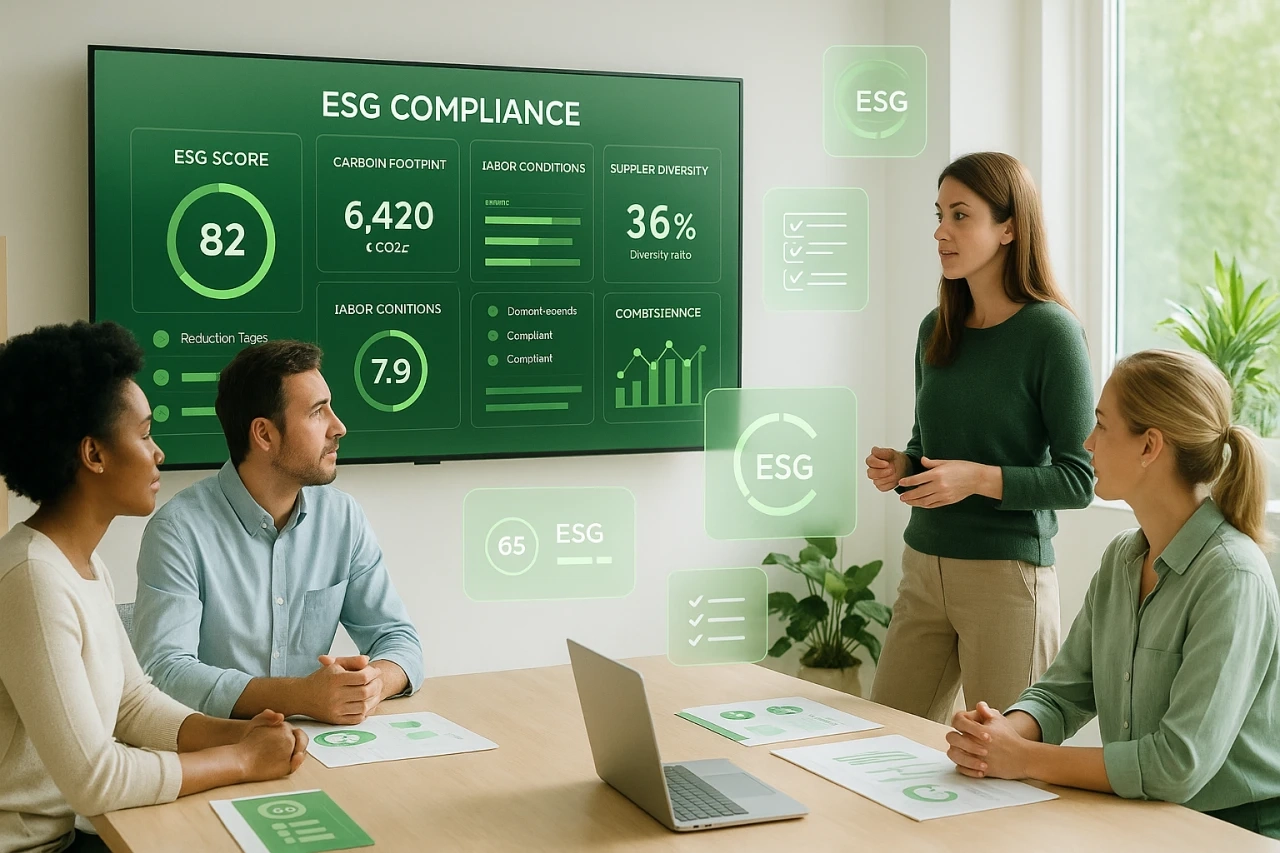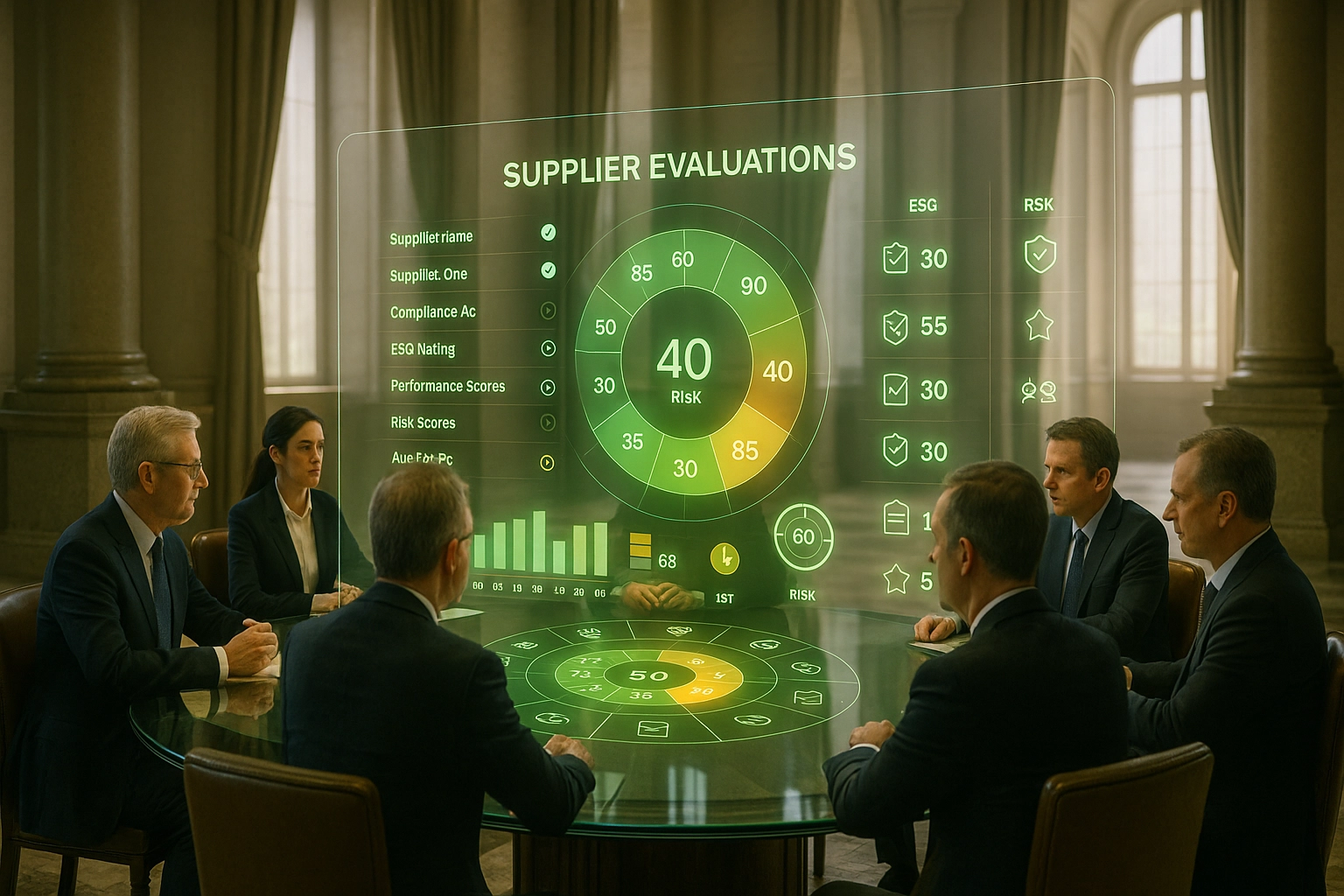Optimizing ESG Evaluation Tools: Enhance Your Supplier Processes

Faced with increasing regulatory pressure and the rise of sustainable transformation, organizations must rethink their third-party governance. Integrating ESG criteria into third-party evaluation tools has become a critical lever to meet regulatory requirements and the growing expectations of stakeholders. Even with the temporary suspension of CS3D, many companies now view supplier ESG commitment as a key risk factor to assess.
This article is designed for organizations that have already deployed ESG evaluation tools and are seeking to optimize existing performance, as well as for companies looking to incorporate ESG criteria into their supplier selection and sourcing processes. Rather than starting from scratch, we help improve current workflows to increase efficiency, reduce administrative burden, and maximize the value of collaborative evaluations.
Where Does ESG Integration Stand Today?
In many organizations, supplier assessments still rely on traditional frameworks: ISO quality certifications, REACH declarations, regulatory attestations, or simple questionnaires. Collaborative approaches are limited, and meaningful responsible initiatives are rarely treated as strategic assets.
The arrival of the CSRD changes this balance: ESG reporting requires reliable, comparable data across stakeholders. According to the 2024 Observatoire des Achats Responsables, only 32% of French companies have ESG evaluation tools integrated into their procurement processes. Managing ESG risks from the selection stage and throughout the supplier lifecycle is essential to operational resilience, especially in complex, international supply chains.
This shift is accelerating in the manufacturing sector, where large contractors now impose standardized ESG criteria. CAC 40 companies have tripled their ESG documentation requirements for critical suppliers since the directive’s enactment. To meet this challenge, optimize your ESG supply chain strategy and build a sector-specific, structured methodology.
Examples of optimization based on your current tools
Excel questionnaires
Migrate to automated collaborative platforms
Basic ERP/SRM modules
Enrich with predictive ESG scoring and real-time alerts
Static supplier portals
Add smart workflows and dynamic dashboards

One-off manual audits
Switch to continuous monitoring using AI and anomaly detection
Why Strengthen ESG Criteria?
Proactively managing ESG criteria brings measurable benefits to operational resilience. It reduces reputational risk by ensuring partners align with the expectations of consumers and investors. Systematic use of sustainability indicatorsbroadens your ESG performance perspective beyond minimum compliance.
Stronger third-party governance on ESG creates operational gains. According to the 2024 EcoVadis study, companies incorporating ESG into supplier evaluations reduce non-compliance incidents by 23% and improve overall supply chain performance by 18%. It also enables better regulatory anticipation and smoother responsible purchasing workflows.
Sector feedback confirms that a collaborative approach boosts CSR oversight and delivers a long-term competitive advantage.
Main Roadblocks to ESG Optimization
Despite growing consensus on ESG’s importance, several barriers slow the transformation of evaluation processes. Sector-specific diversity makes it hard to create harmonized, fit-for-purpose criteria. Many procurement tools still don’t allow for detailed collection or dynamic tracking of ESG indicators.
Overloading partners with redundant or excessive demands leads to supplier fatigue. Long questionnaires and non-collaborative processes reduce data reliability and discourage engaged suppliers—especially in public construction or heavy industries.
Lack of automation is another major barrier. Manual approaches struggle to handle increasing ESG data volumes, reducing organizations’ ability to spot emerging risks and measure sustainable impact. To address this, optimize your supplier ESG evaluations and implement a collaborative methodology that minimizes overhead while maximizing added value.
How to Implement a Step-by-Step Methodology
Step 1: Audit Your Existing Processes
Optimizing an existing ESG strategy starts with auditing your current tools. Are your questionnaires creating supplier fatigue? Are ESG indicators used in decision-making? A detailed review highlights covered ESG areas, assesses information quality, and benchmarks your maturity level against CSRD standards.
Involving key internal stakeholders (procurement, supply chain, compliance) encourages ownership and helps prioritize action. In industrial contexts, this stage also verifies whether ICPE compliance is addressed in supplier risk analysis. A collaborative approach avoids siloed decision-making and builds a shared vision of ESG priorities.
Step 2: Select and Structure Key ESG Criteria
Rationalizing current ESG criteria often starts with simplification. Analyze existing criteria to remove redundancy, drop low-impact indicators, and strengthen decision-critical ones. Criteria should match the business context: CO2 for industry, social traceability for retail, water use in construction.
It’s better to focus on a concise set of actionable ESG indicators than chase exhaustiveness. According to the 2024 Altares-D&B study, integrating ESG scores into evaluations cuts third-party management time by 25% and reduces supplier fatigue.
Formalizing criteria using European benchmarks or CSRD-aligned references ensures adoption. Standardization also enables sector-level comparability of environmental, social, and governance performance.
Step 3: Operational Integration and Change Management
Next, ESG criteria should be embedded in existing workflows—not added as side processes. Enriching platforms (SRM, ERP, partner portals) with ESG modules improves collection without extra steps. Native integration avoids interface overload and simplifies user experience.
In retail, adding a few targeted questions on responsible purchasing at key moments (qualification, contract renewal, annual review) improves decision-making without increasing complexity. Automation handles high volumes of ESG data while maintaining evaluation reliability.
Change management is critical: targeted training, user guides, and regular feedback support ESG adoption. When tools enable narrative input, partner engagement rises significantly. Personalized technical support eases the transition and overcomes resistance.
Finally, continuous performance tracking is essential: completeness rates, response time, partner satisfaction, and quarterly supplier fatigue indicators.
Key ESG maturity indicators to track
> 85%
Completion rate
< 15 jours
Average supplier response time
> 60%
Automated evaluations
> 7/10
Partner satisfaction score
Reduction
Quarterly reduction in supplier fatigue
Source : Avasant 2024-2025
Optimization by Tool Type
SRM/ERP Platforms: Functional Enrichment
Organizations using ERP-integrated ESG modules (SAP Ariba, Oracle, Ivalua) can optimize via predictive scoring and automated alerts. External APIs can enrich supplier profiles with updated ESG data.
Specialized Solutions: Upgrading to Collaborative Models
Users of platforms like EcoVadis or Sustainalytics can increase ROI by improving customized workflows and using sector benchmarking tools to identify top-performing partners.
Internal Tools: Gradual Professionalization
Organizations with in-house tools can integrate recognized standards (GRI, SASB) and automate data collection to reduce manual work and improve reliability.
Sector Insights and Lessons Learned
Manufacturing: Advanced Integration and Streamlining
In manufacturing, contractor pressure has driven widespread ESG integration into supply chain systems. Some platforms now automate energy KPI collection and compliance tracking, enabling agile action plans and audit-ready traceability.
The TELT experience with 4,500 partners shows that a user-friendly platform promotes adoption across regions. This collaborative model supports effective third-party governance in complex international environments.
Streamlined ESG indicators increase analytical clarity and reduce documentation burdens for suppliers. Simplicity fosters transparency and constructive dialogue on shared ESG challenges.
Retail and Distribution: Standardization and Tailored Support
Retail success relies on standardizing key criteria (working conditions, anti-corruption, diversity) and offering real-world examples. Constant partner support facilitates high-value collaborative evaluations, significantly reducing supplier fatigue.
Top retailers focus on four areas
Simplifying workflows via ESG data automation
Highlighting innovations in traceability and social engagement
Adapting tools to partner maturity

Tracking progress with transparent communication
Explore these sector strategies with TPRM and TPGRC tools transforming retail and distribution to enhance operational resilience.
ESG Optimization and Continuous Performance Tracking
Optimizing ESG tools requires a cultural shift toward proactive third-party governance. Success depends on visibility and recognition of ESG performance milestones. This cultural change calls for greater transparency and collaboration across internal workflows.
Alignment with CSRD-compliant ESG reporting frameworks boosts credibility among stakeholders and simplifies audit prep. Companies that standardize ESG processes improve data quality and reduce regulatory gaps.
In the long run, only continuous processes combining tech agility, shared frameworks, and strong change support can balance compliance demands, efficiency, and shared value across the supply chain. To structure this transformation, develop a holistic risk management approach that naturally embeds ESG in your collaborative processes.
These articles might interest you
-
 18 August 2025Reindustrialization: Why Mastering Third Parties Is Now a Strategic ImperativeSecteurFrance’s reindustrialization is underway. Driven by the ambitions of the France 2030 plan, the ecological transition, and economic sovereignty challenges, it’s about much more than simply bringing factories back onto national soil. It requires a deep rethink of sourcing, evaluation, and supplier management processes. Restoring independence and economic sovereignty has become a major strategic issue […]
18 August 2025Reindustrialization: Why Mastering Third Parties Is Now a Strategic ImperativeSecteurFrance’s reindustrialization is underway. Driven by the ambitions of the France 2030 plan, the ecological transition, and economic sovereignty challenges, it’s about much more than simply bringing factories back onto national soil. It requires a deep rethink of sourcing, evaluation, and supplier management processes. Restoring independence and economic sovereignty has become a major strategic issue […]Read more
-
 15 April 2025Supplier Evaluation in the Public Sector: A Strategic Governance ChallengeSecteurThe public sector accounts for a significant portion of economic activity in France and involves a large number of contract holders. As such, public sector actors face critical challenges in managing supplier relationships—especially since third-party qualification has become a cornerstone of public procurement strategies. Beyond basic oversight, it now forms part of a broader approach […]
15 April 2025Supplier Evaluation in the Public Sector: A Strategic Governance ChallengeSecteurThe public sector accounts for a significant portion of economic activity in France and involves a large number of contract holders. As such, public sector actors face critical challenges in managing supplier relationships—especially since third-party qualification has become a cornerstone of public procurement strategies. Beyond basic oversight, it now forms part of a broader approach […]Read more
-
 20 May 2025Deploying a TPRM Platform in Private Companies: Proven Methodology for Effective Third-Party GovernanceSecteurIn a context where TPRM programs require executive-level support to succeed, deploying a TPRM platform is a major strategic challenge. While deployment in the public sector has its own regulatory specificities, multi-site private companies face distinct organizational challenges that call for a tailored methodological approach. This structured methodology transforms third-party evaluation into a true third-party governance lever, going beyond mere documentation compliance to […]
20 May 2025Deploying a TPRM Platform in Private Companies: Proven Methodology for Effective Third-Party GovernanceSecteurIn a context where TPRM programs require executive-level support to succeed, deploying a TPRM platform is a major strategic challenge. While deployment in the public sector has its own regulatory specificities, multi-site private companies face distinct organizational challenges that call for a tailored methodological approach. This structured methodology transforms third-party evaluation into a true third-party governance lever, going beyond mere documentation compliance to […]Read more
-
 14 January 2025ESG and Supply Chain: Emerging Challenges for 2025SecteurLa transformation ESG révolutionne la supply chain en 2025, devenant un impératif stratégique pour toute entreprise moderne. La directive CSRD, entrée en vigueur depuis janvier 2024, impose aux entreprises européennes une transparence totale sur leurs impacts environnementaux et sociétaux. Cette évolution réglementaire majeure s’accompagne de nouvelles exigences comme le CBAM (Carbon Border Adjustment Mechanism) et […]
14 January 2025ESG and Supply Chain: Emerging Challenges for 2025SecteurLa transformation ESG révolutionne la supply chain en 2025, devenant un impératif stratégique pour toute entreprise moderne. La directive CSRD, entrée en vigueur depuis janvier 2024, impose aux entreprises européennes une transparence totale sur leurs impacts environnementaux et sociétaux. Cette évolution réglementaire majeure s’accompagne de nouvelles exigences comme le CBAM (Carbon Border Adjustment Mechanism) et […]Read more



